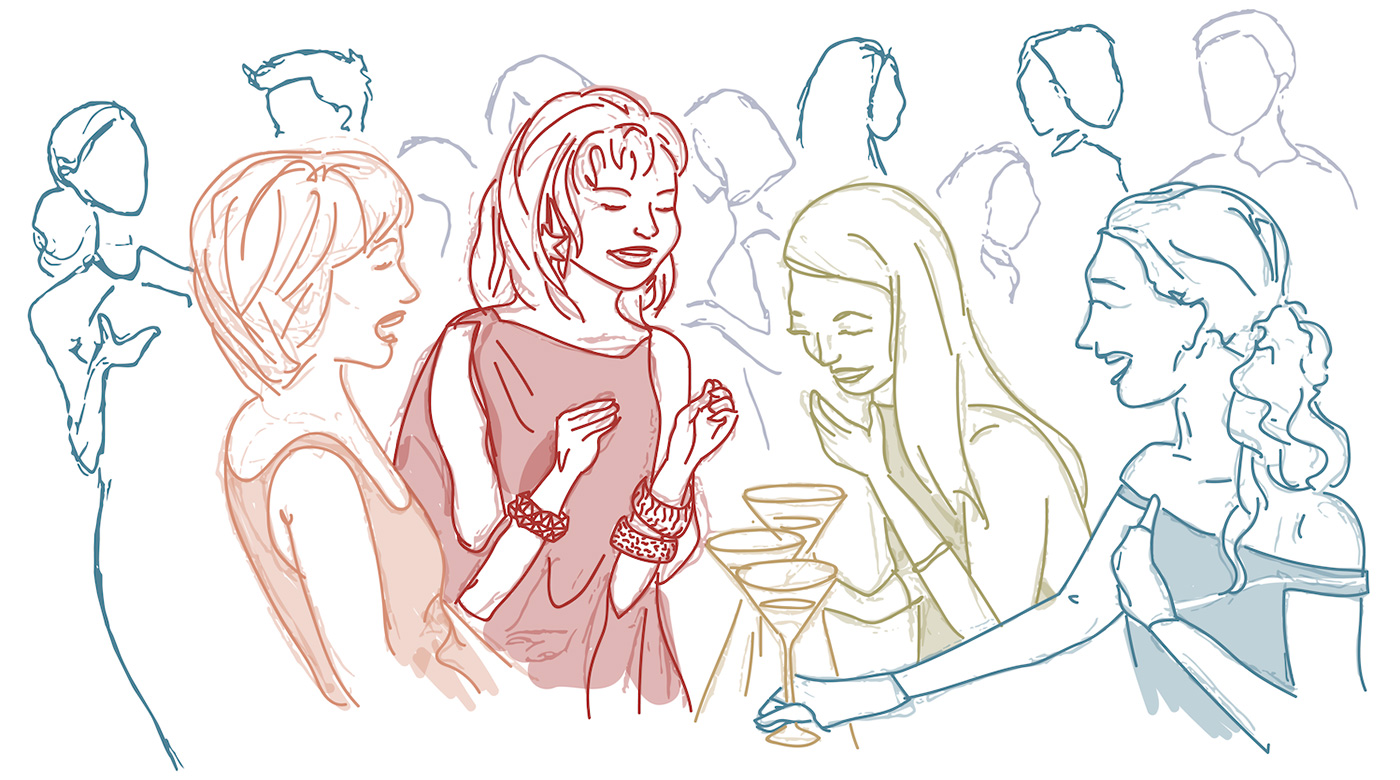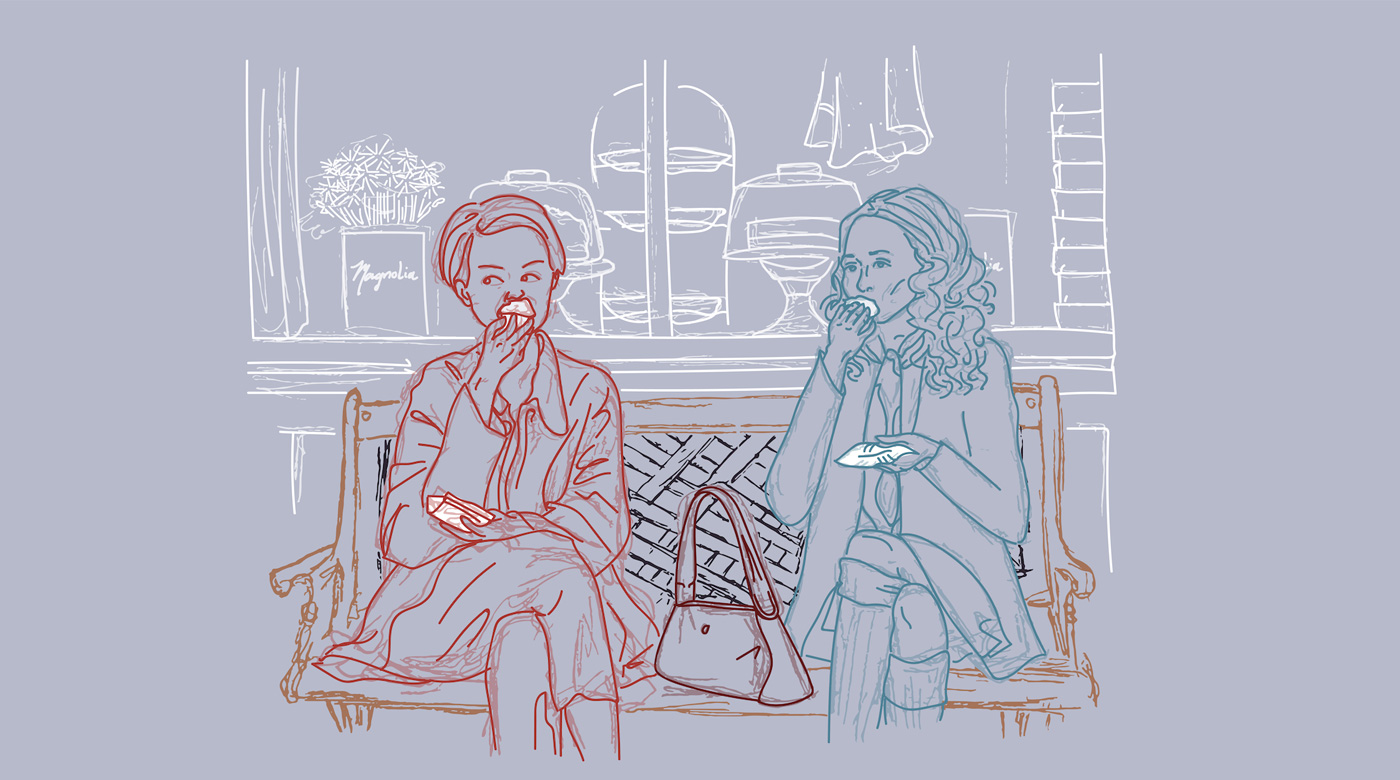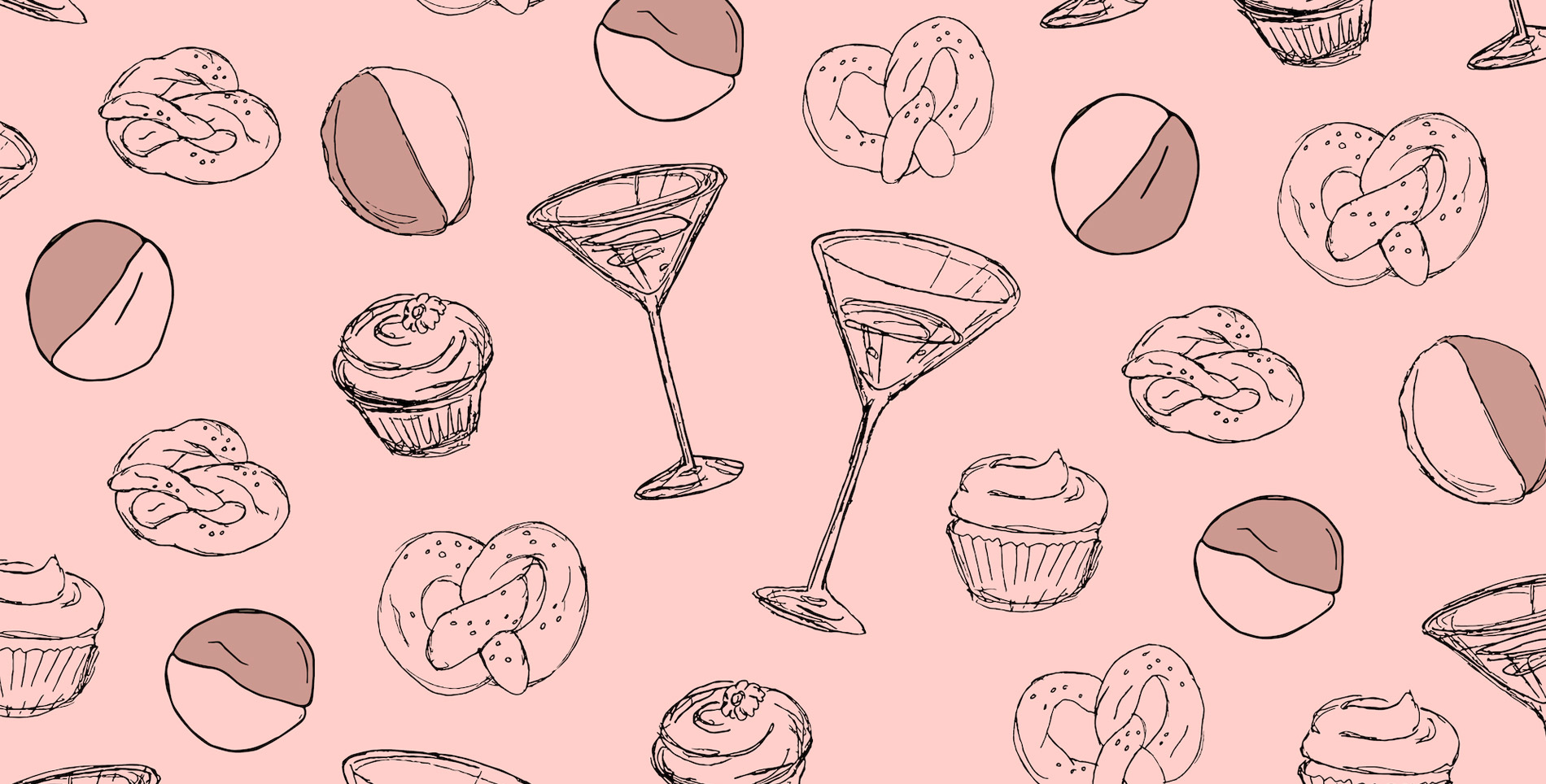It may be hard to believe, but it’s been twenty years since the women of Sex and the City—Carrie, Samantha, Charlotte and Miranda—came clip-clopping into our living rooms in their Manolo Blahniks, and walked away with the cultural zeitgeist.
And for two decades since, throughout six seasons, and of course, thanks to the magic of (sometimes sterilized) syndication and streaming services, they have asked—and answered—so many of the questions on our minds. They were our oracles and spirit guides on the subjects of love and labels—and some things perhaps less commonly discussed. Love or hate the show, it inarguably opened up discussions and encouraged a generation of women to not only be comfortable with their sexuality, but confident, curious about and proud of it.
As author Jennifer Armstrong describes in her new book, Sex and the City and Us, it took the culmination of a century’s worth of feminism waves to allow for the show to be first produced, and then successful. In the nineties, women were beginning to feel newly empowered about their sexuality; they wanted to talk about and even laugh at sex, rather than feel intimidated by it. And today, despite the passage of time, that self-possession of feminine strength is one that could not be more relevant in all businesses—the food world included.
But Sex and the City was about so much more than lust; at its heart, the show was about love and friendship. And what friendship can exist without the conversations that take place over food? In the SATC universe, it’d be hard question to answer, as almost every major scene included eating, drinking or both. Important discourses took place over dishes of eggs, juicy dating details spilled over slices of New York pizza or straight-from-the-sidewalk-vendor pretzels, and of course, those cotton-candy pink cosmos and cutesy Magnolia Bakery cupcakes.
Food was a connector and meals a device, and cocktails weren’t so much social lubricant as they were emotional adhesive. Often, eating and drinking were actually part of the storyline or a critical metaphor for the show, sometimes even as a literal plot point (who can forget a certain declaration of love to Miranda, spelled out on a chocolate chip cookie?). After Carrie calls it quits on smoking, she is constantly snacking while she writes. Charlotte not only takes up Judaism for Harry, she practically becomes a one-woman Zabar’s, and even Samantha spends a good deal of camera time discussing food, as perhaps a predecessor to the modern-day hospitality public relations professional.
In fact so much emphasis was put on what they ate and drank and where they did it, that with their fictional characters, the creators of the show unwittingly inspired global trends, and helped turned a lot of tables at very real New York City restaurants.
But I couldn’t help but wonder, what lasting impact did the show have on our collective food culture?
Armstrong, who studies and has written about the cultural histories of television shows including Seinfeld and The Mary Tyler Moore Show, takes a walk with me down that particular avenue of exploration. In her pages, she tells the story behind the scenes, of how Sex and the City came to be and evolved into one of the most important pop culture touchstones of a generation. She helps explain how a show largely known for shoes and purses had a major influence on the food world, first in New York City (the show’s “fifth lady”), but also radiating around the world. “There’s just something about this show that makes people feel like the people are real,” Armstrong says. “That they have a real personal connection to the characters, and it made people want to do the stuff they were doing. And that definitely includes food.”
Despite its flaws—sometimes controversial characters, outrageously aspirational (and arguably unrealistic) lifestyles, and a lack of diversity perhaps even more egregious in retrospect—there’s no question the show forced certain paradigm shifts, in both love and food. Twenty years after the first episode of the show that would come to define so much about New York City and its women (not to mention the ones everywhere from American suburbs to the Asian continent), I sat down to speak with Armstrong—and we’re talking meals, not Manolos.

——
Stef Ferrari: In the introduction of the book, you discuss how the show informed fashion and the way people dressed, but also note it, “elevated drinking culture to a social obligation in some circles, foisted brunch upon an unsuspecting nation.” Those are certainly some of the most iconic things that came from the show, but really, was there no brunch culture before SATC? Did this show really do that to us?
Jennifer Armstrong: I can’t prove it, but it feels like that to me. It does seem it made brunch into kind of a thing, for women especially. It became shorthand for something more than just a combination of lunch and breakfast. Brunch used to just mean we’re going to have fancy omelettes, but slightly later. This made it into this more social idea of women talking about their feelings and problems.
A big point of this show was these women would gather around food. For the most part, food would really facilitate these big discussions—what I call their “socratic dialogues” about relationships and sex. They got into that mode where one person would bring an issue to brunch and be like, “Okay, anal sex… go!” And each woman would weigh in on that topic with her different viewpoint.
There is something about gathering casually with friends and eating I think could facilitate those open discussions. I really do believe [women] kind of set an agenda for brunch after that. There are groups of female friends who saw that and patterned their habits and lives off of that. I’ve talked to people who have said, “My friends and I have a standing brunch date now like they did,” or that women during the show, or even now when they rewatch it, that in itself can facilitate a discussion of some sexual or relationship issue.
This is very relevant now to discussions we’re having; but it allowed women, when they talk in this way, to figure out their own sexual boundaries before ending up in a situation. These women were expressing their likes and dislikes and feelings, and really figuring it out. Especially before SATC, women were not encouraged to figure that stuff out.
There’s a point in the book where you talk about the director, Susan Seidelman, and how she was really drawn to the show because unlike shows like Friends or Seinfeld that were “New York” shows, this was actually filmed in New York. They were never shy about using the real restaurant names—Asia de Cuba, Il Cantinori, Eleven Madison Park (where there’s a pretty legendary scene), Sushisamba, and that brunch location, which was often Cafeteria or Coffee Shop. All of these were real places, and real things, and they were really affected by the filming there.
I know even personally that I had just [moved] to New York City in the middle of the show’s run, and was aching for that life, and we didn’t have a Yelp app. New York is very overwhelming; there are a million restaurants on every block and a lot of them are good. I would watch the show and say, “Well, I guess I’m going to Sushisamba now.” That was how much it would direct my own experience.
My friend and I used to say we would “play” Sex and the City when we were together. We went on a double date to Sushi Samba, we would go to bars that were on the show. And it definitely affected all these places. They may have died down now, but there was a time that a couple of them even expanded to places like Vegas because they were actually better known there among the masses—the TV viewers. You know how New Yorkers are; they can be so snobby and move on really quickly. It wasn’t just that they were in it, but there’s a whole thing about getting a reservation at Samba and how it’s a status symbol for Samantha. And she was often doing PR for new restaurants; I remember everybody learned about Bed from SATC. And Il Cantinori is still there.
Just in my general experience with these books and covering television, I am very aware of the power of a place having been on a show that people loved. But on SATC it was different because every location was a real location, so people were really driven to these places. They know the people aren’t real, but it’s the closest they can get to interacting with the show itself.
Another point you touch on in the book is the question of how these women could afford their lifestyles—which was always a big point of controversy around the show. You make an interesting point when it comes to food, in that not all of us can buy a $400 pair of shoes, but most of us can afford to have sushi at Sushisamba, or a cupcake. You call it an “affordable entry” into what is such an extremely extravagant, aspirational existence.
Exactly. I asked people as I was going and that was the consensus. The cupcakes and the cosmos were particularly sticky trends, but that seems to be because of the affordability.
Can you talk about the cosmos and the cupcake? They’re obviously the most iconic trends.
I can tell you that having been on a book tour for the last nine days now—it is literally everywhere I go. I really don’t like [cosmos] that much, but I’m not kidding, everywhere: cupcakes and cosmos. Which is not a great combination (laughs); I do not recommend that as a thing you do together. It’s pretty intense.
That’s a lot of sugar!
[Laughs] But it’s clear those are the things; there’s no getting around it. And cosmos, that makes complete sense to me. I was tracking the introduction of them on the show because they’re not there right from the beginning. That is not a signature drink; it sneaks up over the first season. You see a couple in passing, but you don’t hear the name of it. Then there’s an episode where Samantha finally orders one at the bar at a wedding they all go to, and then from then on it becomes more and more their thing.
I want to note that in memory, they always refer to it as a “cosmopolitan,” and that’s a distinction. For me, when you hear someone say that whole word, it sounds more sophisticated.
It’s really true. There are two great things about [the cosmo]. First of all, there’s no better name of a drink for them. It’s pink, it looks good. It looks better than wine. Nothing could have been more perfect for the show; it feels like it was invented for it.
And as you quoted me, it wasn’t just cosmos per se, but drinking culture in general. I do think it reinforced this idea that going out with your friends means either brunch or drinking—that’s what you do, that’s how you bond.
Cupcakes are super interesting for so many reasons, and maybe the biggest is that it was one thirty-second scene. That’s it. They never eat cupcakes again. It’s not like the cosmo, which is ubiquitous on that show. They ate them once. Granted, it’s a clear scene were you definitely know where they are, so maybe that’s part of it—the catching on of Magnolia specifically. And it’s just remarkable because it was only one scene and it basically became a worldwide trend because of Sex and the City. No one can prove that, but the people I talk to seem to believe that’s true, and the people at Magnolia definitely feel that way. [Steve Abrams], who ended up buying Magnolia afterwards said, “I specifically bought it because I felt that it was scalable because of SATC.” That is it.
And Magnolia just announced they’re expanding more internationally. What Steve was saying to me was he really feels that especially in Asian countries, they barely even knew what cupcakes were until SATC. And Asian countries—the ones that have been able to get it—are pretty into SATC.

It’s interesting that Magnolia took off, but something like Tasti D-Lite was sort of exploding at the time; but at this point most of those are closed. There’s a number of scenes in which Tasti D-Lite makes an appearance. One scene in particular was Charlotte telling Harry how sweet she thinks it is that he takes her for Tasti D-Lite every night. In a scene like that, not only is food used in the background, but it’s actually a metaphor in the show. For that episode in particular, Carrie is examining what we accept as real romance, and she uses the fro-yo as the analogy for artifice. We take Tasti D-Lite instead of real ice cream; we accept watered-down romance. And there are many episodes in which she uses food metaphorically, where it’s woven into the actual narrative of the story.
There’s another scene I talk about in the book where [Carrie] is eating a black and white cookie; the writer of that scene told me she specifically chose the black and white cookie because [Carrie is] talking about how she’s going to have to give up the possibility of having children if she stays with The Russian because he doesn’t want to have more kids. [The writer] was like, “The secret metaphor in my own head was that the black and white cookie was there because it’s not a black and white issue.”
[The writers] are very interested in trends and New York City things, and they always have to make metaphors because of [Carrie’s] voiceover. They always think in terms of what would Carrie’s “couldn’t help but wonder” be.
We’ve talked about some of the high brow, trendy things they alluded to, but they always paid homage to classic New York too—like the black and white cookie. That connection to New York is never lost. They’re not just chasing that exclusive new place; there’s down-to-earth moments too. I can count off the top of my head at least three times when we see Carrie eating McDonald’s. You see Carrie eating hot dogs and pretzels off carts, having Gray’s Papaya where she celebrated her book launch…
That’s one of my favorite scenes ever. The driver takes her! Another one I love (which is such a great food thing): after they go to [the restaurant] Raw where they meet Smith Jerrod and Samantha stays to seduce him, Miranda and Carrie go and get pizza at a classic New York pizza place, because that raw food was just not enough.
They really did take those opportunities to explain things. That was the first time I’d heard of the raw food movement, and Samantha actually describes that nothing is cooked over 118 degrees.
Right, and it totally made sense for her character because she was in publicity.
One of the things you discuss as a major flaw of the show was that it had very little, if any, diversity. It was, however, the first time I’d seen a lot of international cuisines. They were always eating Moroccan, Indian, Chinese, sushi—which is interesting considering it was unfortunately probably the only time you saw that specific population represented on the show, when they were serving food.
That’s actually really true. I’ve talked about the lack of diversity on the show, and I think it’s such a testament to how having diversity behind the scenes would have really helped. Maybe this was the only way they really knew how to do that, was through the food.
——
Regardless of function, intended or otherwise, it’s impossible to deny that food was as integral—if not more—as footwear for these four fictional women. Their eating and drinking habits influenced millions of viewers—myself included—in many ways inspiring the restaurant wanderlust that has defined my life and career. What Sex and the City helped set in motion was female empowerment for a new set of priorities—for food, for love, for life—and for future generations of fearless, hungry women who continue to seek both wisdom and wonder, on screen or around the table.
Read more about the cultural influence of the show beyond the food world in Sex and the City and Us by Jennifer Armstrong.







Our comments section is for members only.
Join today to gain exclusive access.